| Columns Retired Columns & Blogs |
"Blinded by the light" :-) ..............
A full set of measurements of the Carver Lightstar was made in its unbalanced mode, with selected measurements repeated for the balanced configuration. Unless otherwise noted, the results below are for unbalanced operation. Also, all measurements (except for the gain check) were made with the normal gain setting.
Following the 1/3-power, one-hour preconditioning test, the Lightstar's heatsink/chassis was too hot to touch comfortably for more than a few seconds.
The Lightstar is non-inverting in the unbalanced mode. Balanced, pin 2 is configured as the positive leg, pin 3 the negative. The input impedance measured 54.2k ohms (unbalanced) and 115.2k ohms (balanced). The output impedance of 0.05 ohms or slightly less (depending on frequency and load) up to 1kHz, and 0.27 ohms or less at 20kHz, should have no practical effect on the amplifier's performance with different loudspeaker loads. Voltage gain into 8 ohms measured 28.8dB unbalanced, and virtually the same, 29dB, balanced in the normal gain setting. Balanced gain in the high-gain setting was 40.8dB. DC offset measured a negligible 3mV in the left channel, 2.2mV in the right.
Signal/noise (ref. and output of 2.83V; ie, a power level of 1W into 8 ohms) measured 73.2dB (75.7dB, balanced) over a 22Hz–22kHz bandwidth, unweighted; 79.6dB (78.9dB, balanced) over a 10Hz–500kHz bandwidth, A-weighted. Unweighted over the latter bandwidth, it measured a rather uninspiring 64dB, suggesting the presence of considerable power-supply noise outside the audible range. Within the audible range, a high-frequency mechanical whistle emanated directly from the Lightstar at various times during the tests. It was well below the irritation threshold for me (though was more annoying for Copy Editor Kristen Weitz, whose desk is in the same room as our test bench, and who frequently grits her teeth at the innumerable tortures we inflict on innocent amplifiers). This whistle became louder the harder the amplifier was pushed. I wouldn't expect it to be a problem in normal operation, however.
Fig.1 shows the frequency response of the Lightstar driven from both its balanced and unbalanced inputs. Note that, in the unbalanced mode, there's a slight peak at the top end (with a maximum of just under 0.5dB at 20kHz into 8 ohms). In the balanced mode, there's no peak here; instead, the response has begun its high-frequency rolloff. Neither deviation should be audibly significant, though the difference (if you compare the balanced and unbalanced modes) may be subtly noticeable.
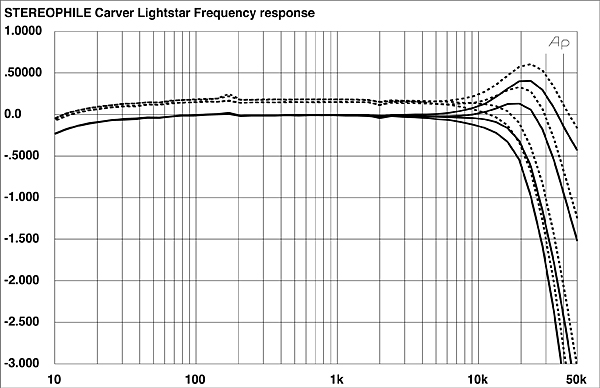
The Lightstar's small-signal 1kHz squarewave response in fig.2 is unlike any I have ever seen. The risetime is fast, with a small, damped overshoot at the end of the rising (or falling) edge of the waveform. But just before the rise—or drop—there's a single cycle of ringing. This same behavior is visible in the 10kHz squarewave response of fig.3. This is very poor squarewave performance. Observed more closely, however, it shows a squarewave with a slow risetime (the probable result of the rapid rolloff in the amplifier's response above audibility observable in fig.1) with that pre-rise, post-drop ringing cycle superimposed on it.
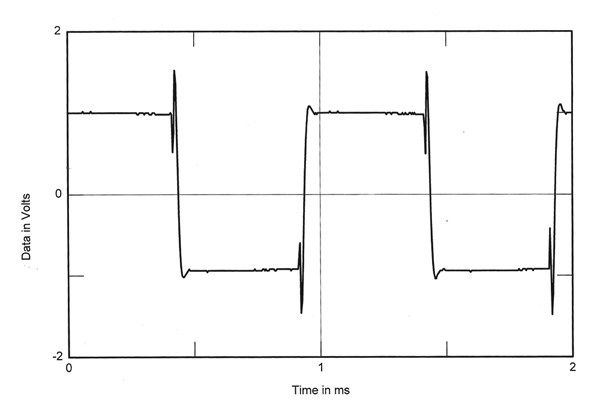
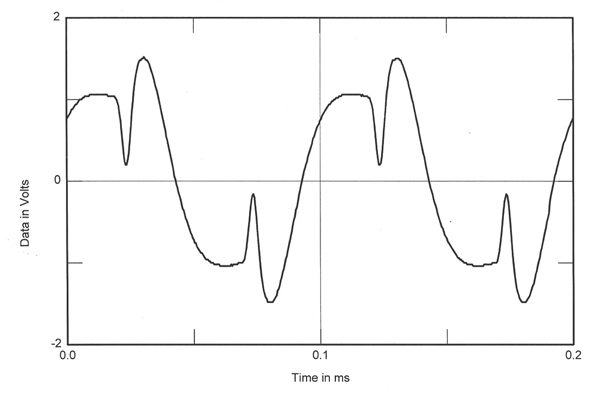
The crosstalk shown in fig.4 is also slightly worse than we're accustomed to observing. Since this is a dual-mono design, I found this result puzzling, though it could relate to circuit-board proximity, noise, or something unique to the unusual design of the amplifier. With a minimum crosstalk of about –49dB above 10kHz, however, the smaller-than-normal channel separation in absolute terms should not affect the audible performance.
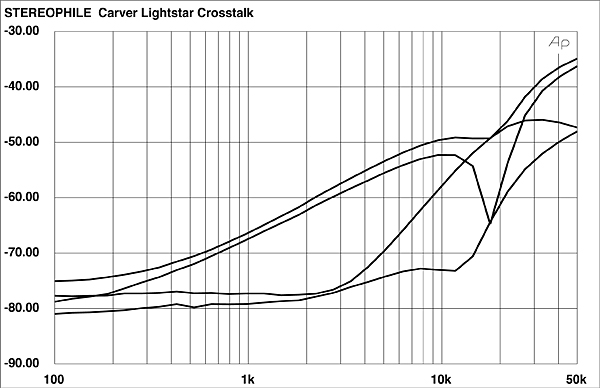
The Lightstar's THD+noise vs frequency results are plotted in fig.5. While the balanced mode shows a slightly higher result, all of the measurements are very closely clustered, with a typical increase at higher frequencies. Whether this result is due to noise or distortion is not apparent.
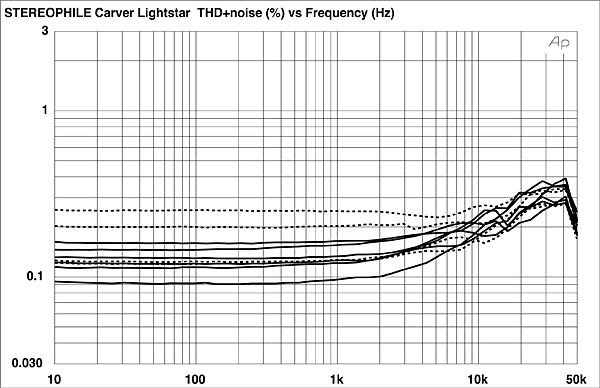
The Carver's distortion waveforms are unlike any I have ever seen. The results varied considerably with load impedance and power output. The results in fig.6 show periodic positive- and negative-going spikes—probably power supply-related—which occur at each half-cycle of the source signal. The "noise" between the spikes appears to follow the source waveform, at least in a general fashion. The distortion waveform in fig.7 is the most distinctive one I obtained during testing. The spikes are still visible, as is a positive-going burst that occurs at each cycle of the source. Again, it appears to "ride" the modulations of the source itself. I wouldn't attempt to predict the audibility of this type of distortion; since it occurs at the same frequency as the source, it may be masked by it.
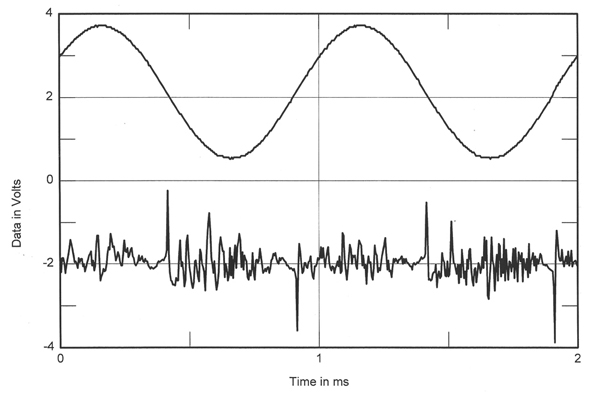
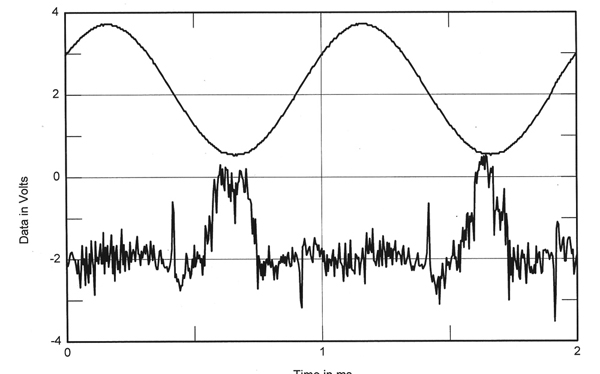
The actual distortion produced by the Lightstar is low compared with the noise level. The low-frequency spectrum of the amplifier's output while reproducing a 50Hz sinewave at 400W into 4 ohms (2/3 rated power at that load) is shown in fig.8. This is an excellent result; all of the artifacts are below –89dB (about 0.0035%), with the third harmonic being the highest in level. Fig.9 shows the amplifier's output spectrum reproducing a combined 19+20kHz signal—the intermodulation products resulting from an input signal consisting of an equal combination of these two frequencies—at 164W into 8 ohms. The largest artifacts here are at 18kHz and 21kHz (–66dB, or about 0.05%), with the next largest at 1kHz (–76.5dB, or about 0.015%). The artifacts from this test signal at 303W into 4 ohms (not shown) were very similar both in distribution and in level. In both cases, this was the maximum power obtainable with this signal prior to visible clipping—not unusual with a 19+20kHz input. Very few amplifiers will approach their rated power with this signal, which has a peak level twice its RMS level.
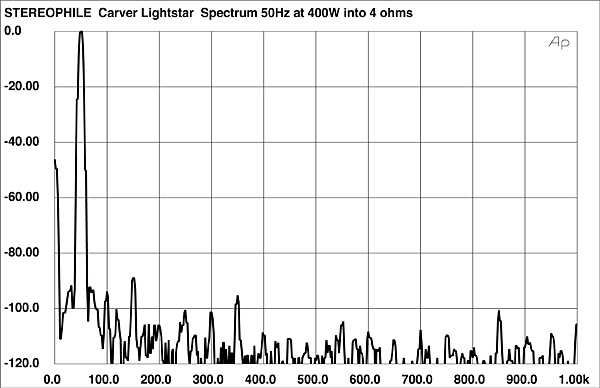
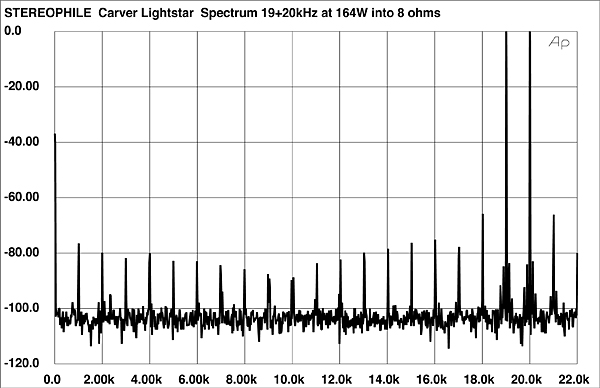
The Carver's discrete clipping levels (at 1% THD+N) are shown in Table 1. The 1kHz, THD+N % vs output power curves are shown in fig.10. This amplifier is clearly a powerhouse. While the power does not quite double with each halving of frequency, it comes close—except at 2 ohms, where it still comes within 50W of meeting its rated 1200W output (the 118V line voltage may have been enough to account for the difference here). The Lightstar certainly ranks among the most powerful amplifiers we have tested, including some which are dramatically more expensive.
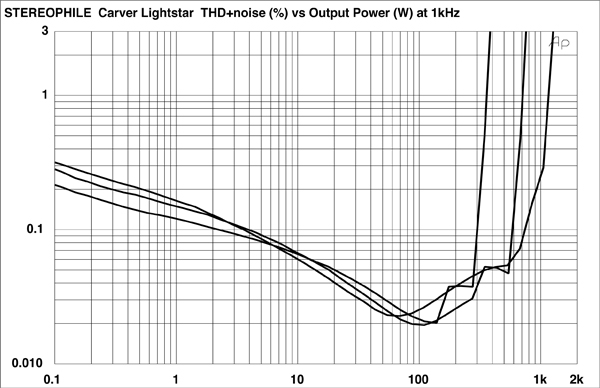
The test-bench results of the Lightstar were generally good (spectacular in the case of its power output). Only two results really gave me pause: the strange squarewave performance, and the lower-than-expected S/N ratio coupled with the pulse-type noise signature. Apparently, neither affected RD's positive listening experiences with the amplifier.—Thomas J. Norton

"Blinded by the light" :-) ..............

I would be an avid reader of a column that “reviewed” vintage gear compared to current equipment. Yes, I know it would be tough making sure the gear was up to snuff based on age, but reading a comparison between a Sony CDP 101 and the current Rega would be fascinating.
Sign me up as a reader of the Anachrophile column!

Beautiful looking amp. While I never had an opportunity to demo a Bob Carver amp per se, I did have a wonderful audition, with his 1st Sunfire amp in 1996.